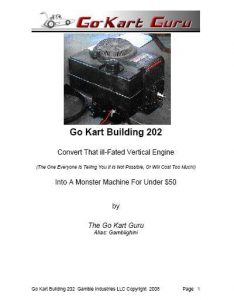I have been reading over the internet the bad reviews on Vertical Engines and their use on go karts. Granted some of the comments are worthy, but I think that vertical engines are getting bad raps for no good reason.
First objection: The standard lawnmower engine requires a heavy blade to act as a flywheel.
Answer: This may be true, but can be overcome with a jack shaft system acting as a flywheel.
Second objection: The standard lawnmower would have to be put on its side and very often the internals on the engine are not designed distribute the oil in the engine in a horizontal position, therefore rework needs to be done inside the engine to get it to operate properly.
Answer: This is true if you are going to convert the engine to being a horizontal engine. (I did that myself in the past, and it is an acceptable method. But it is alot of work, and you had better know what you are doing.)
 Typical Question: We have a really nice 10 hp vertical engine that just came off our riding lawnmower. We want to put it on a go kart. How do we do that?
Typical Question: We have a really nice 10 hp vertical engine that just came off our riding lawnmower. We want to put it on a go kart. How do we do that?
Well it is a good thing you stopped off at the Go Kart Guru, because I have a cheap, quick, and relatively easy solution to this whole problem (and no it is not just throwing out the motor and getting a horizontal engine!). You are going to use that engine, and it is going to put that smile on your face still!
Okay, okay, how is it done?
The answer lies in a peculiar drive systems which we reveal in the Go Kart Building 202 course, where the drive system routing for a Vertical Engine is calculated for you, the system layout is done, and the inside secrets on critical drive components is discussed in great detail.
“Go Kart Building 202” was an excellent manual. I had a vertical engine that was sitting next along one of the walls of my shop that I thought I was never going to be able to use.
Thanks to your instructions on how to make it work, I now have drawn up plans for a new go kart that will have 15hp.
Thank you
Sean Braswell
DIY Over-Simplified Asking For Failure Designs
I have read on other web pages where you just simply wrap this belt and twist this belt onto a drive shaft and you are all set. Sorry to disappoint all you quick and easy go kart makers, but it is just a little more involved than that. It is more than just twisting some belts and tacking on a belt tensioner.
In fact I will give you some pointers.
If you decide to use a twisted belt drive with just a belt tensioner, the system will not work very well. The engine will quite, you will burn up belts, and you will have lousy acceleration.

Well it was addapted to the go kart design that we sell in the plans. We show how to do that in the Go Kart Building 202 course.Vertical Engine Drive Line Problems
The major issue with a vertical engine, as you probably well know, is that the engine shaft points up and down. How in the world are you going to get the power to the wheels without some sort of gear box or something?
 How To Build A Vertical Engined Drive Line
How To Build A Vertical Engined Drive Line
Well the “Or something” is what we discuss in the course. It does not cost alot of money to fabricate.
Again in the Go Kart Building 202 course we discuss actually three (3) different possible layouts and their specific component sizes, proper relationships ect.
Making sure you have components sized properly and fitting properly is 50% of the battle on a go kart. The last thing you want is to be majoraly frustrated with your go kart. Let the Go Kart Guru help. We offer all the inside info required to get this go kart a reality. Click here for more info about How To Make A Go Kart.


